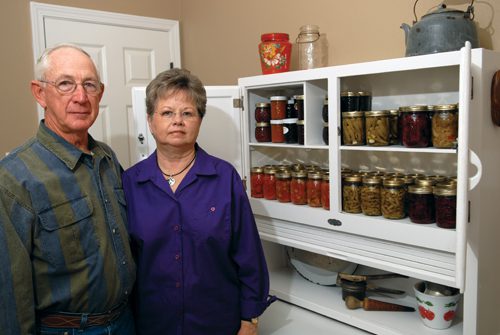By Renee Hunter
Brenda Williams of Vilonia is enjoying the fruits of her labor – literally. She has been making jellies for years, and recently started canning.
Brenda’s mother, Luciel Wharton, canned and made jellies. “I got used to her homemade jellies, and I didn’t like the store-bought,” Brenda said.
Early in her marriage, Brenda made her first jelly using wild muscadines, which she prefers to the domesticated variety. Her favorite muscadine recipe was given to her by a friend, and uses the skins. It is time-consuming because the skin of each grape must be popped but the result is worth the effort.
Brenda’s next effort, with the help of her husband, Bobby, was crabapple jelly made from the fruit of a tree on her parents’ farm. The recipe she used, like several of her recipes, does not call for store-bought pectin because crabapples contain a lot of natural pectin.
“It will turn to jelly while you’re cooking it, almost,” Bobby said of the crabapple juice.
In fact, crabapple juice can be added to other jellies instead of store-bought pectin.
“When you make your preserves without Sure-Jell®, there is just more flavor,” Brenda said.
Her strawberry preserves also contain no added pectin. After cooking, the berries are placed in shallow pans and allowed to sit for 24 hours to cool and gel using the fruit’s natural pectin. The preserves have a syrup-like consistency and are delicious on pancakes, according to Bobby.
 “I don’t pick the strawberries anymore,” Brenda said. “I’m too lazy.”
“I don’t pick the strawberries anymore,” Brenda said. “I’m too lazy.”
This year, Brenda got 14 half-pint jars out of the two three-gallon flats of fresh strawberries she purchased from The High Patch in Vilonia.
Brenda and Bobby also made six jars of blackberry jelly and eight jars of jam out of the nine gallons of wild blackberries he picked. Instead of draining the cooked berries through cheesecloth – the usual method – Bobby ran the fruit through a juicer, which removed the seeds, but kept the pulp. The resulting jelly was cloudier than the cheesecloth variety, but had a lot more body and flavor.
Brenda, often with Bobby’s help, also puts up peach and grape jelly. This year, she made 44 half-pints of jelly, including seven of peach and nine of grape, with the help of her sister, Carol Stroud. For the first time, she used the low-sugar recipe for those made with store-bought pectin.
Jelly-making is time consuming by the time seeds are removed and the fruit is cleaned and cooked. The messy work is done outside using Bobby’s fish cooker and some other special equipment he designed. Adding the pectin, putting the juice in jars and sealing is “a five-minute thing,” Bobby said, and is done in the kitchen. Making a batch of strawberry preserves takes three to four hours, and grapes and blackberries take even longer.
“Anything you have to take the seeds out of is going to take time,’ Bobby said. Apple jelly is probably the cleanest and fastest jelly to make, he added.
Brenda came to canning late because she “wasn’t interested,” she said, explaining that when Luciel Wharton canned, her daughters did the menial labor – snapping beans, shelling peas or cutting corn off the cob. Brenda decided the taste wasn’t worth the effort.
But when she retired, Brenda’s attitude changed. For one thing, she needed to do something with all the produce from Bobby’s garden, which includes okra, tomatoes, green beans, purple hull peas, beets, greens, cucumbers and several varieties of squash. For another, she had more time.
Many of the vegetables Bobby grows can be frozen – corn, peas and bell peppers, for example. But others taste better canned, and homegrown tastes better than store-bought.
As with the jellies, all the messy work of canning is done outside. Luciel Wharton’s 1930s-era pressure cooker does the finish cooking inside.
Bobby is in charge of pickling. He has been pickling beets for years, using Brenda’s grandmother’s recipe. He put up 16 pints this year, adding squash, onions or jalapeños to some jars. For the first time this year he tried his hand at pickled okra, which he loves. He and Brenda also put up 16 pints of okra and tomatoes with onions for the first time this year, and Brenda and her sister also canned green beans – 10 pints – for the first time.
In years when the tomato crop is overwhelming, the couple cans tomatoes and makes green-tomato relish. Bobby’s “tomato routine” makes the job easier: The fruit is blanched in the fish cooker, cooled in a series of baths in ice chests, and skins are removed before the next step.
“It’s not as necessary to enjoy doing the work,” Brenda says of canning, “as to enjoy the food.”
Strawberry Preserves
2 cups prepared whole strawberries (piled high)*
3 cups sugar
Juice of half lemon
1 teaspoon butter (to reduce excess foam)
Use a large, heavy pan with a thick bottom to eliminate burning.
Bring to a rolling boil that can’t be stirred down and boil for 5 minutes. Stir continually.
Skim off any foam.
Pour into a shallow pan and leave for 24 hours, stirring occasionally.
Pour into jelly jars and seal the conventional way or with paraffin.
*It is OK to slice in half the larger berries.
Please go to www.501adsandmags.com for some of Brenda’s favorite recipes.

